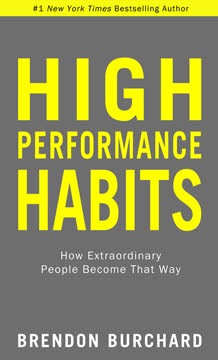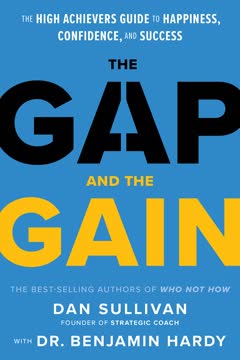重点摘要
1. 高五习惯:自我赋能的简单手势
你无需改变任何东西,就能值得你所需要的爱与接纳。你只需开始给予自己这种认可。
高五习惯 是一种简单而强大的日常练习,每天早晨在镜子前给自己一个高五。这个手势是自爱、自我接纳和鼓励的身体肯定。将这个习惯融入你的日常生活中,你将为新的一天创造一个积极的开端,并开始重塑大脑,以增强自信和动力。
高五习惯的好处:
- 提升自尊和自我价值感
- 增加动力和能量
- 促进积极心态
- 加强与自己的关系
实施高五习惯的方法:
- 每天早晨站在镜子前
- 直视自己的眼睛
- 举起手,给自己一个高五
- 在心中肯定自己今天的价值和潜力
2. 重塑大脑:高五背后的科学
你的网状激活系统(RAS)阻挡了99%周围的信息,使其无法到达你的意识——因为如果不这样,你的头脑会因信息过载而崩溃。
网状激活系统(RAS) 在过滤信息和塑造我们对现实的感知中起着至关重要的作用。通过理解和利用RAS的力量,我们可以重塑大脑,专注于积极的结果和机会,而不是障碍和限制。
高五习惯的运作方式:
- 创建与自我鼓励相关的新神经通路
- 激活RAS,优先考虑积极的自我认知
- 通过持续的实践强化成长心态
额外的RAS训练技巧:
- 在环境中寻找自然出现的心形图案
- 记录与目标相关的积极经历和“迹象”
- 每天练习感恩和积极肯定
3. 摆脱负面自我对话和限制性信念
当前的限制性信念:如果别人有,我就不能。翻转它:他们的成功只是证明我也可以拥有。
识别和挑战限制性信念 对个人成长和成功至关重要。负面的自我对话和破坏性的思维模式可能会阻碍我们实现潜力。通过有意识地翻转这些信念,并用赋能的替代信念取而代之,我们可以创造更积极和支持的内心对话。
摆脱限制性信念的步骤:
- 识别你的负面自我对话和限制性信念
- 用相反的证据挑战这些信念
- 创建替代的、赋能的信念
- 通过肯定和行动强化这些新信念
翻转限制性信念的例子:
- “我不够好” → “我在不断学习和进步”
- “我总是失败” → “每一次挫折都是成长的机会”
- “我不配成功” → “我值得实现我的目标”
4. 将失败视为通往成功的垫脚石
你所学习的一切都在帮助你打破让你停滞不前的思维和行为模式。
将失败重新框定为学习机会 对个人和职业成长至关重要。通过拥抱失败并将其视为成功旅程中必要的一部分,我们可以培养韧性、适应能力和成长心态。
拥抱失败的关键方面:
- 认识到失败是学习过程的自然部分
- 从每一次挫折中提取有价值的教训
- 将失败作为改进和尝试新方法的动力
- 庆祝尝试挑战性目标所需的勇气
从失败中学习的策略:
- 对出错的地方进行事后分析
- 确定具体的改进领域
- 寻求导师或同伴的反馈
- 根据你的学习设定新的调整目标
5. 克服拖延,采取行动
嫉妒他人或对他们评头论足比承认自己生活中缺少某些东西要容易得多。
拖延往往源于恐惧和自我怀疑。 通过识别拖延的根本原因并实施克服策略,我们可以朝着目标和梦想采取持续的行动。
克服拖延的技巧:
- 将大任务分解为更小、更可管理的步骤
- 设定具体的截止日期并对自己负责
- 使用五秒法则来启动行动
- 想象完成任务的积极结果
创造动力:
- 从任务中最简单或最愉快的部分开始
- 承诺只花5分钟在某个任务上
- 为采取行动和完成任务而奖励自己
- 跟踪进展并庆祝小胜利
6. 建立自信,信任直觉
当你喜欢自己和自己的生活时,可能会让你的妈妈、孩子、朋友、教会,甚至爱尔兰都感到不安。为自己做正确的事在开始时会很困难。
自信和直觉 是应对生活挑战和做出与真实自我相符的决策的强大工具。通过培养自我信任和学会倾听内心的智慧,我们可以做出更能带来满足感和真实感的选择。
建立自信和信任直觉的步骤:
- 练习自我同情和积极的自我对话
- 设定并实现小而可达成的目标
- 庆祝自己的优点和成就
- 倾听内心的感觉,尊重自己的直觉
增强直觉的练习:
- 定期冥想以平静心灵,获取内在指导
- 记录自己的感受和直觉
- 练习基于直觉做出小决策
- 反思过去直觉正确的经历
7. 在逆境中培养韧性
我很好。我安全。我被爱着。
韧性是从挫折中反弹并适应挑战性环境的能力。 通过培养韧性,我们可以更轻松地应对生活的起伏,并在逆境中保持积极的心态。
韧性的关键组成部分:
- 情绪调节
- 灵活思维
- 强大的支持网络
- 目标感和意义感
建立韧性的策略:
- 练习正念和减压技巧
- 培养成长心态,迎接挑战
- 培养强大的人际关系,并在需要时寻求支持
- 参与带来快乐和意义的活动
8. 可视化和显化的力量
你的心智旨在帮助你实现梦想。
可视化和显化 是实现目标和创造我们渴望生活的强大工具。通过利用想象的力量,并将我们的思想和行动与愿望对齐,我们可以增加成功和个人满足的机会。
有效的可视化技巧:
- 创建你期望结果的详细心理图像
- 在可视化中调动所有感官
- 定期练习可视化,最好是每天
- 将可视化与积极肯定结合起来
显化过程:
- 清晰定义你的目标和愿望
- 相信实现梦想的可能性
- 朝着目标采取灵感行动
- 对机会和巧合保持开放
- 信任过程并练习耐心
9. 应对生活转变,拥抱变化
新生活的代价是旧生活。
生活的转变和变化 既令人兴奋又充满挑战。通过培养优雅和韧性地应对这些转变的能力,我们可以拥抱新的成长和自我发现的机会。
拥抱变化的策略:
- 认可并处理与变化相关的情绪
- 专注于你在这种情况下可以控制的事情
- 寻求朋友、家人或专业人士的支持
- 将变化视为个人成长的机会
成功应对生活转变的建议:
- 保持灵活的心态,开放接受新可能性
- 创建新的例行和习惯,以支持你的新环境
- 设定现实的期望,对自己保持耐心
- 反思过去成功转变的经历,以获得信心和指导
最后更新日期:
FAQ
What's "The High 5 Habit" about?
- Core Concept: "The High 5 Habit" by Mel Robbins introduces a simple yet transformative habit of giving yourself a high five in the mirror each morning to improve self-esteem and self-worth.
- Purpose: The book aims to help readers take control of their lives by fostering a positive relationship with themselves, which is foundational for achieving personal and professional goals.
- Methodology: Robbins combines personal anecdotes, scientific research, and practical exercises to demonstrate how this habit can reprogram the subconscious mind and change one's perspective on life.
- Broader Impact: The habit is part of a larger framework that encourages self-love, resilience, and the pursuit of one's dreams, ultimately leading to a more fulfilling life.
Why should I read "The High 5 Habit"?
- Self-Improvement Focus: If you're looking to improve your self-esteem and confidence, this book offers a unique and practical approach.
- Actionable Advice: Robbins provides clear, actionable steps that can be easily integrated into daily routines, making it accessible for anyone.
- Scientific Backing: The book is grounded in research, offering evidence-based strategies that support the effectiveness of the high five habit.
- Inspiration and Motivation: Through personal stories and motivational insights, Robbins inspires readers to believe in themselves and take action towards their goals.
What are the key takeaways of "The High 5 Habit"?
- Self-Celebration: The habit of high fiving yourself in the mirror is a powerful act of self-celebration and affirmation.
- Mindset Shift: Changing your mindset from self-criticism to self-encouragement can have profound effects on your mental health and motivation.
- Neuroscience Insights: The book explains how this simple gesture can rewire your brain, creating new neural pathways that support positive thinking.
- Daily Practice: Consistency in practicing the high five habit can lead to long-term changes in how you perceive yourself and your capabilities.
How does the High 5 Habit work?
- Positive Association: The act of high fiving is universally associated with celebration and encouragement, which your brain recognizes and responds to positively.
- Interrupts Negative Thoughts: When you high five yourself, it interrupts negative self-talk and shifts your focus to a more positive and supportive mindset.
- Neurobic Exercise: This habit acts as a neurobic exercise, engaging your brain in a new way that strengthens positive neural connections.
- Daily Ritual: By making it a daily ritual, you reinforce the habit and its benefits, gradually transforming your self-perception.
What is the science behind the High 5 Habit?
- RAS Activation: The Reticular Activating System (RAS) in your brain filters information based on what you deem important; the high five habit helps prioritize positive self-perception.
- Neuroplasticity: Engaging in this habit creates new neural pathways, promoting a shift from self-doubt to self-acceptance and confidence.
- Emotional Impact: The physical act of high fiving releases dopamine, a feel-good hormone, enhancing your mood and motivation.
- Research Support: Studies cited in the book show that simple gestures like high fives can significantly boost motivation and persistence.
How can I start practicing the High 5 Habit?
- Morning Routine: Incorporate the high five into your morning routine by doing it first thing after waking up and before checking your phone.
- Mirror Interaction: Stand in front of a mirror, look yourself in the eye, and give yourself a high five, focusing on the positive energy it brings.
- Consistency is Key: Make it a daily practice to reinforce the habit and its positive effects on your mindset.
- Track Progress: Consider keeping a journal to note changes in your mood and self-perception over time.
What are some challenges people face with the High 5 Habit?
- Initial Discomfort: Many people feel awkward or silly at first, as it's an unfamiliar practice of self-affirmation.
- Skepticism: Some may doubt its effectiveness due to its simplicity, questioning how such a small act can lead to significant change.
- Consistency Issues: Like any new habit, maintaining consistency can be challenging, especially if one doesn't see immediate results.
- Overcoming Self-Criticism: Those with deeply ingrained negative self-talk may find it difficult to shift their mindset initially.
What are the best quotes from "The High 5 Habit" and what do they mean?
- "You deserve to be celebrated." This quote emphasizes the importance of self-love and the need to acknowledge and celebrate oneself daily.
- "How you see yourself is how you see the world." It highlights the idea that your self-perception shapes your interactions and experiences in life.
- "You can work hard, while being soft with your soul." This encourages balancing ambition with self-compassion, reminding readers that kindness to oneself is crucial.
- "Your dreams are your responsibility. No one is coming." It serves as a call to action, urging readers to take ownership of their aspirations and actively pursue them.
How does "The High 5 Habit" relate to Mel Robbins' other works?
- Continuation of Themes: Like "The 5 Second Rule," this book focuses on simple, actionable strategies to overcome self-doubt and take control of one's life.
- Building on Success: Robbins expands on her previous work by introducing a new habit that complements the principles of courage and action.
- Consistent Message: Both books emphasize the power of small actions in creating significant life changes, reinforcing the idea that transformation starts with mindset shifts.
- Broader Impact: "The High 5 Habit" adds to Robbins' repertoire of tools for personal development, offering readers another method to enhance their self-esteem and motivation.
What are some real-life examples of the High 5 Habit in action?
- Personal Stories: Robbins shares her own experiences and those of others who have successfully integrated the habit into their lives, leading to increased confidence and resilience.
- Diverse Applications: The habit has been used by people from various backgrounds, including students, professionals, and parents, to improve their self-perception and achieve goals.
- Community Feedback: The book includes testimonials from readers who have experienced positive changes, demonstrating the habit's effectiveness across different contexts.
- Global Reach: The High 5 Habit has gained traction worldwide, with individuals sharing their stories and encouraging others to adopt the practice.
How can the High 5 Habit help with overcoming self-doubt?
- Interrupts Negative Patterns: The habit disrupts cycles of self-doubt by replacing them with positive reinforcement and self-encouragement.
- Builds Confidence: Regular practice helps build self-confidence by reinforcing the belief that you are capable and deserving of success.
- Focuses on Strengths: By celebrating yourself daily, you shift your focus from perceived weaknesses to your strengths and achievements.
- Empowers Action: The habit encourages taking action despite self-doubt, fostering a mindset of resilience and determination.
What is the long-term impact of practicing the High 5 Habit?
- Sustained Self-Love: Over time, the habit fosters a deep sense of self-love and acceptance, transforming how you view yourself and your potential.
- Improved Relationships: As you develop a healthier relationship with yourself, it positively impacts your interactions and relationships with others.
- Increased Resilience: The habit builds resilience, helping you navigate challenges with a more optimistic and proactive mindset.
- Life Transformation: Consistent practice can lead to significant life changes, as you become more aligned with your goals and confident in your ability to achieve them.
评论
《高五习惯》获得了大多数积极的评价,读者们称赞其简单而有效的自我提升方法。许多人觉得在镜子前给自己一个高五的概念令人振奋,能够增强自信。评论者们欣赏罗宾斯的个人故事、科学依据和可操作的建议。部分批评意见包括内容的重复性和过于冗长。该书被认为对那些刚接触自助书籍或在焦虑中挣扎的人特别有帮助。总体而言,读者们觉得这本书激励人心,具有变革性,许多人在日常生活中实施了这一习惯。
Similar Books
















